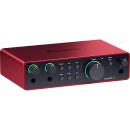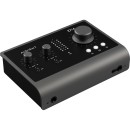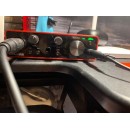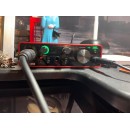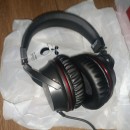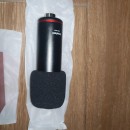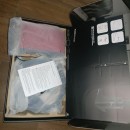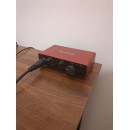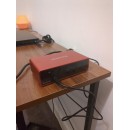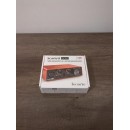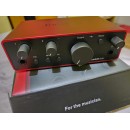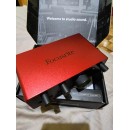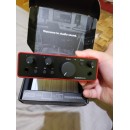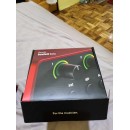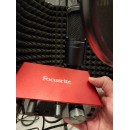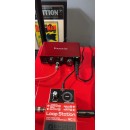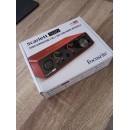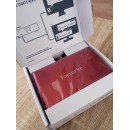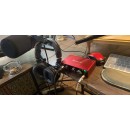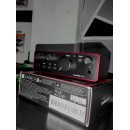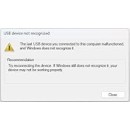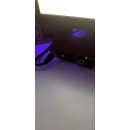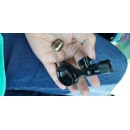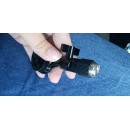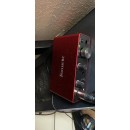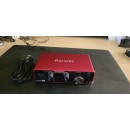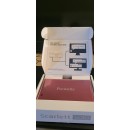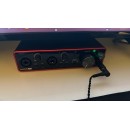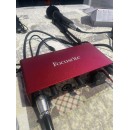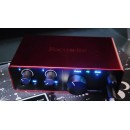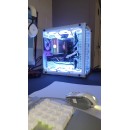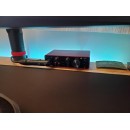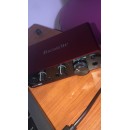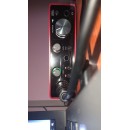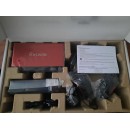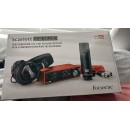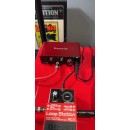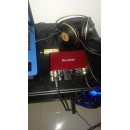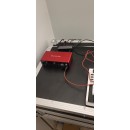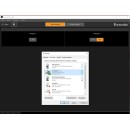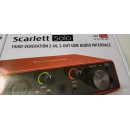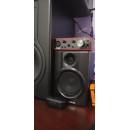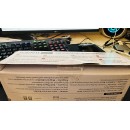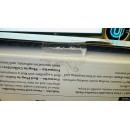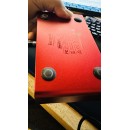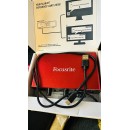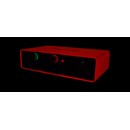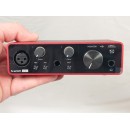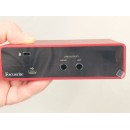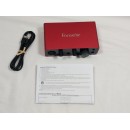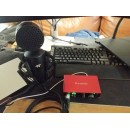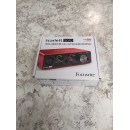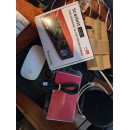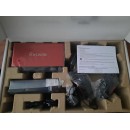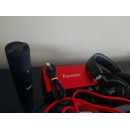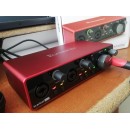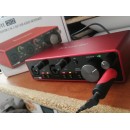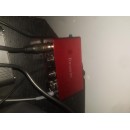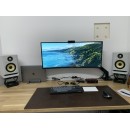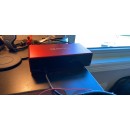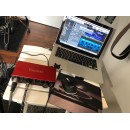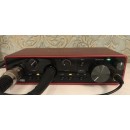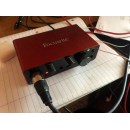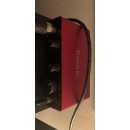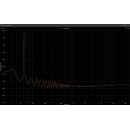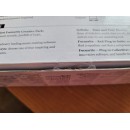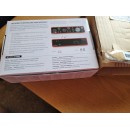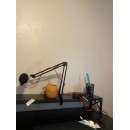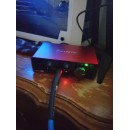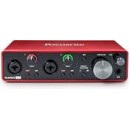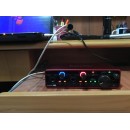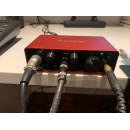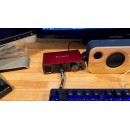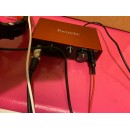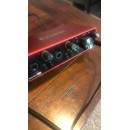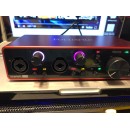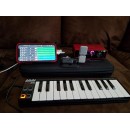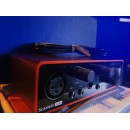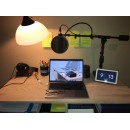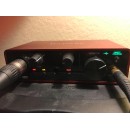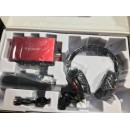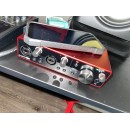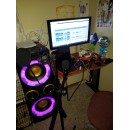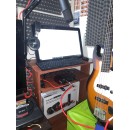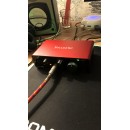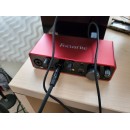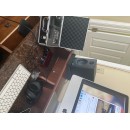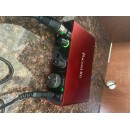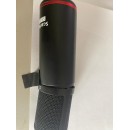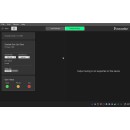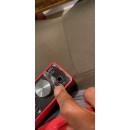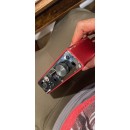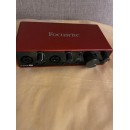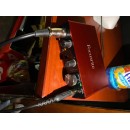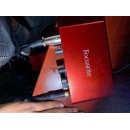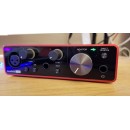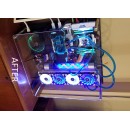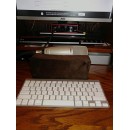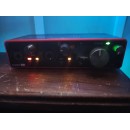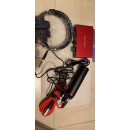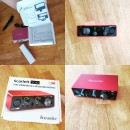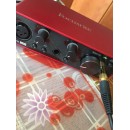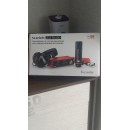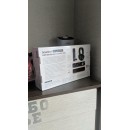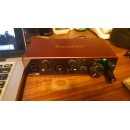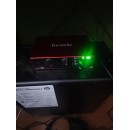Audient iD14 MKII vs Focusrite Scarlett 2i2 (4th Gen): Comprehensive Comparison
The Focusrite Scarlett 2i2 (4th Gen) continues the Scarlett series' reputation for reliability and quality. It features two award-winning preamps, high headroom, and minimal distortion, ensuring clean and accurate recordings. The 2i2 offers 24-bit/192kHz AD-DA converters, which provide pristine sound quality. Its compact and durable design makes it ideal for mobile recording setups. Additionally, the interface includes the Air mode, which enhances the high frequencies for a brighter, more open sound. The Scarlett 2i2 is highly user-friendly, making it an excellent choice for beginners and seasoned musicians alike. Its bundle of software, including Ableton Live Lite and Focusrite’s Red Plug-in Suite, adds significant value for those starting their recording journey.
On the other hand, the Audient iD14 MKII is a more feature-rich interface, designed for users who need a bit more flexibility and expansion options. It boasts Audient’s renowned console-grade preamps and the JFET DI input, delivering a warm, analog sound that many professionals appreciate. The iD14 MKII supports a higher input and output count with its 10-in/6-out configuration, which can be expanded via ADAT, making it suitable for larger recording setups. The interface also features 24-bit/96kHz converters, ensuring excellent audio fidelity. One of the standout features of the iD14 MKII is its ScrollControl, which allows the volume knob to be used as a virtual scroll wheel, providing intuitive control over your DAW parameters. The solid build quality and sleek design further enhance its appeal to professional users who need a robust and reliable interface.
While both interfaces offer exceptional audio quality and performance, the choice between the two largely depends on the user's specific needs. The Focusrite Scarlett 2i2 (4th Gen) is perfect for those seeking a straightforward, high-quality interface with essential features and excellent software support. In contrast, the Audient iD14 MKII is ideal for users who require more inputs and outputs, expandability, and additional control features for a more versatile recording experience.
Specifications, Advantages, and Disadvantages
| User Rating Based on Analysis of Reviews | |
|---|---|
|
Show More |
| Pros: | |
|---|---|
|
|
| Cons: | |
|---|---|
|
|
| Find Best Price | Find Best Price |
| Key Specs | |
|---|---|
| Channels of I/O | |
| Analog: 2 Inputs / 2 Outputs at 192 kHz |
Analog: 2 Inputs / 6 Outputs at 96 kHz Digital: 8 Input / 0 Output at 48 kHz |
| Maximum Sampling Rate | |
| 192 kHz / 24-Bit | 96 kHz / 24-Bit |
| Number of Microphone Inputs | |
| 2 | 2 Preamps |
| Analog Audio I/O | |
| 2x XLR 3-Pin Balanced Mic Input 2x 1/4" TRS Balanced/Unbalanced Line/Hi-Z Input (Front Panel) 2x 1/4" TRS Balanced Monitor Output 1x 1/4" TRS Headphone Output (Front Panel) |
2x Combo XLR-1/4" TRS Balanced Mic/Line Input 1x 1/4" TRS Unbalanced Hi-Z Input (Front Panel) 4x 1/4" TRS Balanced Line/Monitor Output 1x 1/4" TRS Unbalanced Headphone Output (Front Panel) 1x 1/8" / 3.5 mm TRS Unbalanced Headphone Output (Front Panel) |
| Digital Audio I/O | |
| 1x TOSLINK Optical ADAT / S/PDIF Input (S/MUX Support) | |
| Host Connection | |
| 1x USB-C | 1x USB-C |
| OS Compatibility | |
| macOS Windows |
macOS 10.11.6 or Later macOS 11.1 or Later Windows 7 or Later |
| Power Requirements | |
| USB Bus Power, USB Power Adapter (Not Included) | USB Bus Power |
The Focusrite Scarlett 2i2 (4th Generation) provides a straightforward I/O configuration with 2 analog inputs and 2 analog outputs at a maximum sampling rate of 192 kHz / 24-bit. It includes 2 XLR 3-pin balanced mic inputs and 2 front-panel 1/4" TRS balanced/unbalanced line/Hi-Z inputs. For monitoring, it offers 2 rear-panel 1/4" TRS balanced monitor outputs and a front-panel 1/4" TRS headphone output. It lacks digital audio I/O options but connects to the host via USB-C and is compatible with both macOS and Windows operating systems. It operates on USB bus power, offering an additional option for a USB power adapter (not included).
In contrast, the Audient iD14 MKII presents a more versatile I/O setup with both analog and digital capabilities, featuring a total of 10 inputs and 6 outputs. It supports a maximum sampling rate of 96 kHz / 24-bit. The analog inputs include 2 combo XLR-1/4" TRS balanced mic/line inputs and a front-panel 1/4" TRS unbalanced Hi-Z input. It also offers 4 rear-panel 1/4" TRS balanced line/monitor outputs, a front-panel 1/4" TRS unbalanced headphone output, and a 1/8" / 3.5 mm TRS unbalanced headphone output. Unique to the iD14 MKII is its digital audio I/O with an optical TOSLINK ADAT / S/PDIF input supporting S/MUX. This interface also uses a USB-C connection and is compatible with macOS 10.11.6 or later, macOS 11.1 or later, and Windows 7 or later. It is powered solely by USB bus power.
Overall, the Focusrite Scarlett 2i2 is a solid choice for simple, high-quality recordings with its higher sampling rate and straightforward analog I/O. The Audient iD14 MKII, while having a lower maximum sampling rate, offers greater flexibility with additional analog and digital I/O options, making it suitable for more complex recording setups.
| General | |
|---|---|
| Channels of I/O | |
| Analog: 2 Inputs / 2 Outputs at 192 kHz |
Analog: 2 Inputs / 6 Outputs at 96 kHz Digital: 8 Input / 0 Output at 48 kHz |
| Maximum Sampling Rate | |
| 192 kHz / 24-Bit | 96 kHz / 24-Bit |
| Number of Microphone Inputs | |
| 2 | 2 Preamps |
| Input Level Adjustment | |
| 2x Knob | 2x Knob |
| Expansion Slots | |
The Focusrite Scarlett 2i2 (4th Generation) provides a straightforward and efficient setup with 2 analog inputs and 2 analog outputs, both capable of handling audio at a maximum sampling rate of 192 kHz / 24-bit. It includes two microphone inputs and utilizes two knobs for input level adjustment. However, it lacks built-in DSP capabilities, built-in microphones, and expansion slots, making it a more streamlined option for users who prioritize simplicity and high-quality audio recording without the need for additional processing or expansion.
In contrast, the Audient iD14 MKII offers a more versatile setup with 2 analog inputs and 6 analog outputs at a maximum sampling rate of 96 kHz / 24-bit, alongside 8 digital inputs at 48 kHz. Like the Scarlett 2i2, it features two microphone preamps and two knobs for input level adjustment. The Audient iD14 MKII, however, stands out with its additional digital input capabilities, providing greater flexibility for users who may need more input channels for larger recording sessions. It also lacks built-in DSP, built-in microphones, and expansion slots, but the increased number of outputs and digital inputs can be a significant advantage for more complex audio setups.
In summary, the Focusrite Scarlett 2i2 (4th Generation) is ideal for users seeking a high-resolution, plug-and-play interface with minimalistic features, while the Audient iD14 MKII caters to those who need more input and output flexibility, especially in a digital format, albeit at a slightly lower maximum sampling rate.
| Signal Processing | |
|---|---|
| Gain/Trim Range | |
| Mic/Line Inputs: Up to +69 dB Hi-Z Inputs: 62 dB |
Mic/Hi-Z Inputs: 58 dB Hi-Z Inputs: 40 dB |
The Audient iD14 MKII lacks certain features that the Scarlett 2i2 does not list explicitly. It has no pad, high-pass filter, or solo/mute functions. These omissions may influence users seeking more advanced signal processing capabilities directly on their interface. On the other hand, the Scarlett 2i2 does not list these features either, suggesting both devices might focus on streamlined functionality rather than extensive onboard processing options.
In summary, the Focusrite Scarlett 2i2 (4th Generation) stands out with its higher gain/trim range, making it suitable for a broader variety of recording applications. The Audient iD14 MKII, while offering slightly lower gain ranges, is also a robust option but lacks additional features like pad, high-pass filter, and solo/mute, which might be crucial for some users.
| Connectivity | |
|---|---|
| Analog Audio I/O | |
| 2x XLR 3-Pin Balanced Mic Input 2x 1/4" TRS Balanced/Unbalanced Line/Hi-Z Input (Front Panel) 2x 1/4" TRS Balanced Monitor Output 1x 1/4" TRS Headphone Output (Front Panel) |
2x Combo XLR-1/4" TRS Balanced Mic/Line Input 1x 1/4" TRS Unbalanced Hi-Z Input (Front Panel) 4x 1/4" TRS Balanced Line/Monitor Output 1x 1/4" TRS Unbalanced Headphone Output (Front Panel) 1x 1/8" / 3.5 mm TRS Unbalanced Headphone Output (Front Panel) |
| Phantom Power | |
| 48 V, Selectable On/Off | 48 V ± 4 V, Selectable On/Off (Selectable on Individual Inputs) |
| Digital Audio I/O | |
| 1x TOSLINK Optical ADAT / S/PDIF Input (S/MUX Support) | |
| Host Connection | |
| 1x USB-C | 1x USB-C |
| Host Connection Protocol | |
| USB 2.0 | USB 3.0 / 3.1/3.2 Gen 1 |
| USB (Non-Host) | |
| 1x USB-C (Power Input) | |
| Sync I/O | |
| Network I/O | |
| MIDI I/O | |
Starting with the analog audio I/O, the Focusrite Scarlett 2i2 offers 2x XLR 3-pin balanced mic inputs and 2x 1/4" TRS balanced/unbalanced line/Hi-Z inputs on the front panel, making it suitable for users who need versatility in input types. It also includes 2x 1/4" TRS balanced monitor outputs and a single 1/4" TRS headphone output on the front panel. This configuration is fairly standard and caters well to home studio setups where primary needs are recording vocals and instruments with minimal fuss.
In contrast, the Audient iD14 MKII provides 2x combo XLR-1/4" TRS balanced mic/line inputs and an additional 1/4" TRS unbalanced Hi-Z input on the front panel, allowing for greater flexibility in connecting various types of gear. The iD14 MKII also excels in output options, offering 4x 1/4" TRS balanced line/monitor outputs, a 1/4" TRS unbalanced headphone output, and a 1/8" (3.5 mm) TRS unbalanced headphone output on the front panel. This makes it more adaptable for users who require multiple monitoring solutions or work in a more complex audio setup.
When it comes to phantom power, both interfaces provide 48 V selectable on/off options. However, the Audient iD14 MKII offers this capability with more precision, allowing selection on individual inputs and providing 10 mA per channel, which can be crucial for certain high-end condenser microphones that require stable phantom power.
In terms of digital audio I/O, the Audient iD14 MKII has a significant advantage with a TOSLINK optical ADAT/S/PDIF input, supporting S/MUX, which allows for expansion with additional channels. The Focusrite Scarlett 2i2, on the other hand, lacks any digital audio I/O, making it less expandable in comparison.
For host connection, both interfaces utilize a USB-C connection. However, the Focusrite Scarlett 2i2 operates on USB 2.0 protocol, whereas the Audient iD14 MKII uses the more advanced USB 3.0/3.1/3.2 Gen 1 protocol, potentially offering better data transfer speeds and lower latency, which can be beneficial in more demanding recording environments.
Neither interface provides sync I/O, network I/O, or MIDI I/O, and both lack wireless capabilities, focusing instead on providing high-quality analog and digital audio connections.
In summary, the Focusrite Scarlett 2i2 is a solid, straightforward interface ideal for smaller setups and users who need essential recording capabilities without the need for extensive expansion. The Audient iD14 MKII offers more flexibility, additional output options, and expandability through digital I/O, making it a better fit for more complex setups and users who require a higher degree of versatility in their audio interface.
| Performance | |
|---|---|
| Frequency Response | |
| XLR Mic Inputs: 20 Hz to 20 kHz ±0.06 dB 1/4" Line Inputs: 20 Hz to 20 kHz 0.05 dB 1/4" Hi-Z Inputs: 20 Hz to 20 kHz 0.15 dB |
A/D Converters: 10 Hz to 40 kHz ±0.5 dB D/A Converters: 10 Hz to 40 kHz ±0.1 dB Headphone Outputs: 10 Hz to 40 kHz ±0.25 dB Mic, Line Inputs: 10 Hz to 40 kHz ±0.5 dB (Min Gain) 20 Hz to 22 kHz ±1 dB (Max Gain) Hi-Z Inputs: 10 Hz to 20 kHz ±0.5 dB |
| Maximum Input Level | |
| XLR Mic: 16 dBu 1/4" Line: 22 dBu 1/4" Hi-Z: 12 dBu |
Mic Inputs: +12 dBu Line Inputs: +21 dBu Hi-Z Inputs: +10 dBu |
| Maximum Output Level | |
| 1/4" Line: +16 dBu |
Headphone Outputs: +5.46 Vrms (600-Ohm Load) |
| Headphone Output Power | |
| 1/4": 32 mW into 33 Ohms 22 mW into 300 Ohms |
223 mW into 30 Ohms (Max) 280 mW into 62 Ohms (Max) 100 mW into 600 Ohms (Max) |
| Impedance | |
| XLR Mic Inputs: 3 Kilohms 1/4" Line Inputs: 60 Kilohms 1/4" Hi-Z Inputs: 1 Megohms 1/4" Line Outputs: 100 Ohms 1/4" Headphone Outputs: < 50 Ohm |
Mic Inputs: 2.8 Kilohms (Balanced) Line Inputs: > 8 Kilohms (Balanced) |
| Dynamic Range | |
| XLR Mic Inputs: 116 dBA 1/4" Line Inputs: 115.2 dBA 1/4" Hi-Z Inputs: 113 dBA 1/4" Line Outputs: 120 dB 1/4" Headphone: 112 dB (at 33 Ohms) 115 dB (at 300 Ohms) Digital A/D Converters: 120 dB Digital D/A Converters: 130 dBA |
A/D Converters: 120 dB (A-Weighted) D/A Converters: 125.5 dB (A-Weighted) Headphone Outputs: 125.5 dB (A-Weighted) |
| THD+N | |
| XLR Mic Inputs: -100 dB (at 8 dB Gain) 1/4" Line Inputs: -100 dB (at 8 dB Gain) 1/4" Hi-Z Inputs: -80 dB (at Minimum Gain) 1/4" Line Outputs: -109 dB 1/4" Headphone Outputs: -99 dB (at 33 Ohms) -108 dB (at 300 Ohms) Digital A/D Converters: -110 dB Digital D/A Converters: -115 dB |
Mic/Line Inputs: 0.0017% (at 0 dBu) Hi-Z Inputs: 0.1% (at 0 dBu) A/D Converters: < 0.001% (at -1 dBFS) D/A Converters: < 0.0006% (at -1 dBFS) Headphone Outputs: < 0.0009% (at -1 dBFS) |
| EIN | |
| XLR Mic Inputs: -127 dBu A-Weighted |
Mic/Line Inputs: -129 dBu A-Weighted |
Frequency Response: The Focusrite Scarlett 2i2 offers a frequency response of 20 Hz to 20 kHz with various tolerances for different input types, such as ±0.06 dB for XLR mic inputs and ±0.15 dB for 1/4" Hi-Z inputs. In contrast, the Audient iD14 MKII provides a wider frequency response, ranging from 10 Hz to 40 kHz with tolerances like ±0.5 dB for A/D converters and ±0.1 dB for D/A converters. The Audient also specifies its response for different gain levels, such as 10 Hz to 40 kHz ±0.5 dB at minimum gain and 20 Hz to 22 kHz ±1 dB at maximum gain.
Maximum Input Level: The Scarlett 2i2 supports a maximum input level of 16 dBu for XLR mic inputs, 22 dBu for 1/4" line inputs, and 12 dBu for 1/4" Hi-Z inputs. The Audient iD14 MKII offers slightly lower maximum input levels, with +12 dBu for mic inputs, +21 dBu for line inputs, and +10 dBu for Hi-Z inputs.
Maximum Output Level: The maximum output level for the Scarlett 2i2 is +16 dBu for 1/4" line outputs. The Audient iD14 MKII, however, specifies its maximum headphone output level as +5.46 Vrms for a 600-ohm load, which translates to a high level of output power suitable for a range of headphone impedances.
Headphone Output Power: The Scarlett 2i2 provides 32 mW into 33 ohms and 22 mW into 300 ohms. The Audient iD14 MKII offers significantly higher power, with 223 mW into 30 ohms, 280 mW into 62 ohms, and 100 mW into 600 ohms, making it more versatile for driving various headphone types.
Impedance: The Scarlett 2i2 has an impedance of 3 kilohms for XLR mic inputs, 60 kilohms for 1/4" line inputs, 1 megohm for 1/4" Hi-Z inputs, 100 ohms for 1/4" line outputs, and less than 50 ohms for 1/4" headphone outputs. The Audient iD14 MKII has a mic input impedance of 2.8 kilohms and line input impedance of greater than 8 kilohms, showing slight differences in impedance levels but still within professional range.
Dynamic Range: The Scarlett 2i2 offers a dynamic range of 116 dBA for XLR mic inputs, 115.2 dBA for 1/4" line inputs, 113 dBA for 1/4" Hi-Z inputs, and 120 dB for 1/4" line outputs. The Audient iD14 MKII provides a dynamic range of 120 dB for A/D converters and 125.5 dB for D/A converters, with headphone outputs also boasting a high dynamic range of 125.5 dB, indicating superior performance.
THD+N: The Scarlett 2i2 has a THD+N rating of -100 dB for XLR mic inputs at 8 dB gain, -100 dB for 1/4" line inputs at 8 dB gain, -80 dB for 1/4" Hi-Z inputs at minimum gain, and -109 dB for 1/4" line outputs. The Audient iD14 MKII shows lower THD+N values, with 0.0017% for mic/line inputs at 0 dBu, 0.1% for Hi-Z inputs at 0 dBu, and very low THD+N values for its converters and headphone outputs, indicating high fidelity.
EIN: The Scarlett 2i2 and the Audient iD14 MKII both offer excellent Equivalent Input Noise (EIN) levels, with the Scarlett at -127 dBu A-weighted for XLR mic inputs and the Audient slightly better at -129 dBu A-weighted for mic/line inputs.
Overall, both the Focusrite Scarlett 2i2 and Audient iD14 MKII provide high-quality audio performance, but the Audient iD14 MKII shows superior specifications in several key areas, including dynamic range, THD+N, and headphone output power, making it a more powerful tool for audio professionals seeking higher fidelity and versatility.
| Digital Audio | |
|---|---|
| Sample Rates | |
| 44.1 / 48 / 88.2 / 96 / 176.4 / 192 kHz | 44.1 / 48 / 88.2 / 96 kHz |
| Bit Depths | |
| 24-Bit | 24-Bit |
| Sync Sources | |
| Internal | ADAT, Internal, S/PDIF |
The Focusrite Scarlett 2i2 (4th Generation) supports a wide range of sample rates, including 44.1, 48, 88.2, 96, 176.4, and 192 kHz, making it versatile for various recording and playback scenarios. It operates at a bit depth of 24-bit, which is standard for professional audio interfaces, ensuring precise and high-resolution audio capture and reproduction. The sync source for the Scarlett 2i2 is internal, meaning it relies solely on its internal clock for synchronization.
On the other hand, the Audient iD14 MKII supports sample rates of 44.1, 48, 88.2, and 96 kHz, which covers most common recording needs but does not extend to the higher 176.4 and 192 kHz rates available on the Scarlett 2i2. Like the Scarlett 2i2, it also operates at a 24-bit depth. The iD14 MKII offers more versatility in sync sources with support for ADAT, Internal, and S/PDIF, providing greater flexibility in complex audio setups. Additionally, it features extremely low latency, with 0.65 ms at 44.1 kHz and 0.31 ms at 96 kHz, which is crucial for real-time monitoring and performance.
In summary, the Focusrite Scarlett 2i2 (4th Generation) offers a broader range of sample rates but is limited to internal sync. The Audient iD14 MKII, while supporting a slightly narrower range of sample rates, provides additional sync options and very low latency, making it a strong contender for users needing versatile synchronization and real-time performance capabilities. Both interfaces maintain a professional 24-bit depth, ensuring quality audio processing.
| Audio Storage & Playback |
|---|
| Compatibility | |
|---|---|
| OS Compatibility | |
| macOS Windows |
macOS 10.11.6 or Later macOS 11.1 or Later Windows 7 or Later |
The Focusrite Scarlett 2i2 (4th Generation) is compatible with both macOS and Windows operating systems, extending its usability to a wide range of users. Additionally, it supports mobile app compatibility with iPadOS, making it a convenient choice for users who prefer mobile recording setups.
On the other hand, the Audient iD14 MKII offers compatibility with macOS 10.11.6 or later, macOS 11.1 or later, and Windows 7 or later. This device has specific processor requirements, supporting Intel and Apple M1 processors for Mac, and a 1.6 GHz Intel Core 2 processor for PC. It also requires a minimum of 1 GB of RAM. Unlike the Focusrite Scarlett 2i2, the Audient iD14 MKII does not support mobile device compatibility. However, it does necessitate an available USB-C port and includes a USB cable. Additionally, an internet connection is required for registration and software/driver downloads, which might be a consideration for users without reliable internet access.
In summary, the Focusrite Scarlett 2i2 (4th Generation) offers broader OS compatibility and mobile app support, making it versatile for both desktop and mobile recording scenarios. The Audient iD14 MKII, while more specific in its hardware and software requirements, may appeal to those who prioritize a robust desktop setup with professional-grade audio capabilities.
| Power | |
|---|---|
| Power Requirements | |
| USB Bus Power, USB Power Adapter (Not Included) | USB Bus Power |
The Focusrite Scarlett 2i2 (4th Generation) offers flexible power options. It can be powered via USB bus power, making it highly convenient for mobile recording setups or users who prefer a minimalist setup without additional power adapters. Additionally, it supports a USB power adapter (not included), providing an alternative method for powering the device. The technical specifications indicate that it requires a 5 VDC at 900 mA power adapter and has a power consumption of 4.5 watts. This versatility in power options allows for adaptability in various recording environments.
In contrast, the Audient iD14 MKII strictly relies on USB bus power for its operation. This dependency on USB bus power means that it draws all necessary power directly from the connected computer via the USB Type-C connection. While this can simplify the setup process and reduce the need for additional power sources, it also implies that the interface's performance is contingent on the computer's ability to supply adequate power through the USB port.
In summary, the Focusrite Scarlett 2i2 (4th Generation) offers more flexibility with its dual power options, potentially catering to a wider range of user scenarios, from mobile setups to more stationary studio environments. The Audient iD14 MKII, while simpler in its power requirements by relying solely on USB bus power, might be more suitable for users with consistent and reliable USB power sources.
| Physical | |
|---|---|
| Dimensions | |
| 7.1 x 4.6 x 1.87" / 18 x 11.7 x 4.75 cm | 6.8 x 4.7 x 2.4" / 17.3 x 12 x 6.2 cm (Including Controls and Protrusions) |
Starting with dimensions, the Focusrite Scarlett 2i2 measures 7.1 x 4.6 x 1.87 inches (18 x 11.7 x 4.75 cm) and weighs 1.3 lb (595 g). This compact and lightweight design makes it a portable option for musicians and producers who need to record on the go. On the other hand, the Audient iD14 MKII has dimensions of 6.8 x 4.7 x 2.4 inches (17.3 x 12 x 6.2 cm), including controls and protrusions, which makes it slightly bulkier in height compared to the Scarlett 2i2. The Audient iD14 MKII does not list its weight in the provided specifications, but its slightly larger physical footprint may make it less portable compared to the Scarlett 2i2.
In terms of additional features, the Audient iD14 MKII includes a Kensington Security Slot, an anti-theft feature that provides extra security for the device. This is particularly useful in studio environments where the interface may be left unattended or in shared spaces. The Focusrite Scarlett 2i2 does not list any similar security features, which might be a consideration for users looking for added physical security for their equipment.
Overall, the Focusrite Scarlett 2i2 offers a more portable and lightweight option, while the Audient iD14 MKII provides an additional security feature that could be valuable in certain settings. Users will need to weigh these differences based on their specific recording needs and environments.
| Packaging Info | |
|---|---|
| Package Weight | |
| 1.9 lb | 2.33 lb |
| Box Dimensions (LxWxH) | |
| 8.2 x 7 x 2.6" | 9 x 6 x 3.6" |
Starting with the package weight, the Focusrite Scarlett 2i2 is lighter, weighing in at 1.9 lb compared to the Audient iD14 MKII, which has a package weight of 2.33 lb. This difference in weight may be significant for users who prioritize portability and ease of transport.
In terms of box dimensions, the Focusrite Scarlett 2i2 measures 8.2 x 7 x 2.6 inches, making it slightly more compact in terms of length and height. On the other hand, the Audient iD14 MKII has dimensions of 9 x 6 x 3.6 inches, which gives it a bit more depth. The larger box dimensions of the Audient iD14 MKII could suggest a more robust build or additional components within the packaging.
Both interfaces utilize USB Type-C connectivity, which is known for its fast data transfer rates and compatibility with modern computing devices. However, the comparison in terms of specific weights and dimensions reveals that the Focusrite Scarlett 2i2 is more lightweight and compact, whereas the Audient iD14 MKII is slightly heavier and larger, potentially indicating different design priorities or feature sets within the product builds.
| Customer Images | |
|---|---|
| Videos | |
|---|---|
|
|
|
